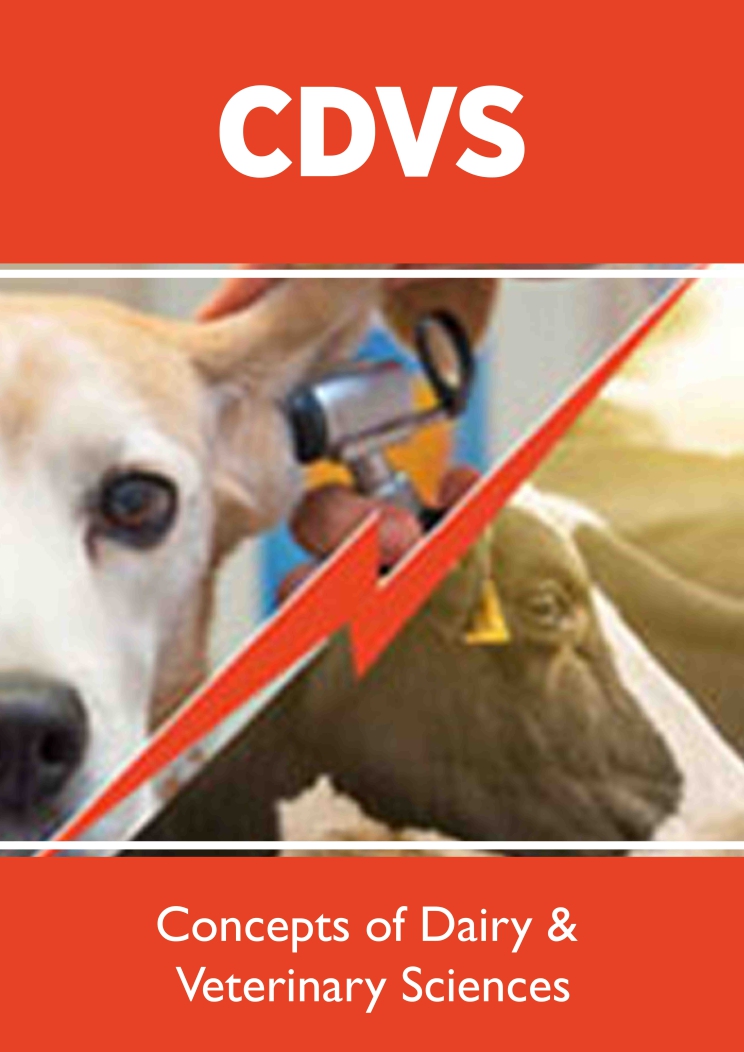
Lupine Publishers Group
Lupine Publishers
Menu
ISSN: 2637-4749
Research Article(ISSN: 2637-4749) 
Effects of Post-Thaw Culture and Embryo Type on In Vitro Bovine Embryo Development and Hatching Rates Volume 5 - Issue 4
Looman J1, Hickerson S1, Gibbons J1*
- 1Texas Tech University- School of Veterinary Medicine, Amarillo TX, 79106
Received: April 19, 2023; Published: April 24, 2023
Corresponding author: Gibbons J, Texas Tech University- School of Veterinary Medicine, Amarillo TX, 79106
DOI: 10.32474/CDVS.2023.05.000219
Abstract
Embryo transfer is an important assisted reproductive technology (ART) that enables cattle producers to reach their genetic, reproductive, and financial goals and overcome reproductive challenges. The ability to freeze embryos provides flexibility and further genetic preservation. The aim of this study was to evaluate the impact of post-thaw culture conditions and the in vitro development and hatching rates of various types of frozen / thawed embryos. In Experiment 1, post thaw development was compared between 96 frozen-thawed embryos frozen in Ethelene Glycol (EG) or Glycerol (Gly). In Experiment 2, post thaw development was compared between 57 frozen / thawed embryos cultured in media containing 10% or 25% fetal bovine serum (FBS) or no serum. In Experiment 3, post thaw development was compared between 80 frozen-thawed embryos that were in vitro produced or in vivo derived. In Experiment 4, post thaw development was compared between 64 frozen-thawed embryos produced with either conventional or sex-sorted semen. Following thawing, embryos were incubated in vitro for 24 and 48 hours. Embryos were graded and staged and evaluated for hatching at thawing, 24, and 48 hours.
Data was analyzed with one way ANOVA and chi square for binary outcomes. Results indicated a cryoprotectant and type of embryo (in vivo versus in vitro) effect on post thaw viability; however, serum supplementation nor the use of sexed semen to produce in vivo embryos impacted the post thaw viability. Although somewhat inconvenient, the use of Gly as a cryoprotectant may produce favorable reproductive outcomes for in vivo derived embryos. Further, cryopreservation of in vitro derived embryos in Gly or vitrification may also yield favorable results compared to EG. Fundamentally, in vitro culture of frozen / thawed bovine embryos for 24 hours prior to transfer to recipients, may allow embryos that seem morphologically normal and similar, to separate themselves into groups that have a high potential to produce pregnancies versus those that do not.
Introduction
Embryo transfer is an enabling ART offering vital solutions for various reproductive challenges. Its application is utilized in multiple species, benefiting not only animals but also humans facing infertility. Since its introduction into routine cattle practice in the 1970s, embryo transfer has evolved significantly, providing continuous support for dairy producers [1]. Both super ovulation and in vitro embryo production offer tools to meet producer’s specific goals and challenges. The number of in vitro produced embryos transferred and reported to the International Embryo Technologies Society (IETS) surpassed in vivo derived embryos transferred around 2016 [2]. Both technologies enhance the accuracy of genetic selection, intensify dam-side genetic selection, enable genomic selection at the embryo stage, and facilitate the production of dairy X dairy, dairy X beef, and beef X beef offspring from dairy cattle [3].
The ability to freeze embryos is a major advancement in bovine embryo transfer. Embryo cryopreservation technology provides flexibility to the producers as well as increases genetic preservation. Successful cryopreservation had been achieved for both in vivo derived and in vitro produced embryos [4]. As reported by the IETS, the number of frozen-thawed embryos has been increasing for several years. Of the in vitro produced embryos transferred in 2022, 44.3% were frozen thawed, a rise from 41.3% in 2021 and 39.5% in 2020 [2]. Frozen thawed in vivo derived embryos have also increased from 60.5% in 2021 to 64.8% in 2022. In total, cryopreserved embryos account for nearly half (49.1%) of all cattle embryos transferred worldwide [2].
Poor fertility is a challenge in global dairy production, often leading to the culling of many dairy cows [5,6]. To address these challenges, reproductive technologies such as embryo transfer, embryo freezing, and sexed semen offer promising approaches. However, a major complication lies in the multitude of factors involved in producing in vivo and in vitro embryos and establishing pregnancies post transfer. Additionally, once the embryo is produced, multiple protocols with different cryoprotectants are used for freezing or vitrifying embryos. Variable pregnancy rates among different embryo types and procedures could be the result of many different factors, some of which lie with the embryo recipient. There is a need to mitigate these factors to further optimize embryo transfer and increase offspring production [1]. When measuring pregnancy rates after embryo transfer, it is essential to consider the substantial variation of that the recipients have on these pregnancy rates. Therefore, by focusing on post-thaw culturing of embryos, a more controlled environment is an option to evaluate the viability of cryopreserved embryos. This approach allows for examination of embryo development, changes in quality grades, and hatching rates, ultimately aiming to improve the success of frozen/thawed embryo transfer programs in dairy cattle.
The aim of this study was to evaluate the impact of postthaw culture conditions and the development and hatching rates of various types of frozen embryos. In the first experiment, development of embryos frozen in either ethylene glycol or glycerol were compared. In Experiment 2, the addition of FBS to the culture media was tested. In Experiment 3, in vitro produced and in vivo derived frozen embryos were compared. Lastly, in Experiment 4 the post-thaw development of in vivo embryos produced with sexed semen and conventional semen was compared.
Materials and Methods
Straws containing frozen embryos were removed from liquid nitrogen and exposed in the air for 5 seconds before being warmed in a water bath at 30°C for 30 seconds. Straws containing embryos frozen in EG were cut and the embryo was deposited directly into holding media. Straws containing embryos frozen in Gly were cut and deposited in 1 molar sucrose for 8 minutes to rehydrate before placing into holding media. The thawed embryo was washed through an additional well of holding media before going through a wash drop of culture media and placed into a 5 ml culture drop. In the serum study, thawed embryos were randomly placed into drops containing either 10% or 25% FBS or control. Embryos were cultured at 38.5°C in a fully humidified 5% CO2, 5% O2, 90%N environment. Embryos were re-evaluated at 24- and 48-hour postthaw for development, quality grade, and hatching. Embryos were evaluated according to IETS standards [7]. The code for stage of development is numeric, ranging from “1”, a 1-cell embryo to “9”, expanding hatched blastocyst. Hatching was defined as the obvious emergence of the trophectoderm with enclosed blastocoel through a thinning zona pellucida. Embryo quality was also numerical and based on morphological integrity of embryos ranging from “1” to “4”.
Data for numerical grades and stages at different time points were analyzed by one-way ANOVA. The difference of stages between two time points were calculated and analyzed by oneway ANOVA. Contingency tables were constructed for development and hatching outcomes. Each single embryo was the observational unit with a binary outcome recorded (achieved advancement in developmental stage or not or hatched or not). Data were analyzed via Chi Square. Pairwise comparison was performed using a 2-proportion z-tests. The significance level was set at P < 0.05. All analyses were performed on R software, Version 3.1.
Two hundred ninety- seven frozen embryos were used across 4 experiments. In Experiment 1, post thaw development was compared between 96 frozen-thawed embryos frozen in Ethelene Glycol or Glycerol. In Experiment 2, post thaw development was compared between 57 frozen-thawed embryos cultured in media containing 10% or 25% fetal bovine serum or no serum. In Experiment 3, post thaw development was compared between 80 frozen-thawed embryos that were produced either in vitro produced or in vivo. In Experiment 4, post thaw development was compared between 64 frozen-thawed embryos produced with either conventional or sex-sorted semen.
Results
Experiment 1
Embryo development (Table 1) was significantly higher (p= 0.0001) in the Gly-frozen embryos which advanced on average 1.8 stages compared to EG-frozen embryos which advanced 0.6 stages of development. The EG-frozen embryos had a higher average postthaw stage (4.8 ± 0.2) compared to Gly-frozen embryos (4.1 ± 0.1); however, had a significantly lower average developmental stage after 24 hours in culture (EG = 5.3 ± 0.2; Gly = 5.9 ± 0.2). Embryo quality grades were not significantly different after thawing or culture. There was no significant difference in the number of embryos that hatched between the groups. Overall, the number of embryos that advanced in stages after post thaw culture for 24 hours was significantly higher (p= 0.005) in Gly-frozen embryos (38) compared to EG-frozen embryos (24).
Experiment 2
There were no significant differences seen in development stages nor quality grades post thaw, 24 hours of culture, or 48 hours of culture between thawed embryos cultured in media supplemented with no serum, 10% or 25% serum. No significant difference was seen between the number of stages advanced at 24 and 48 hours among the groups. Additionally, no significant difference was seen in the number of embryos that developed or hatched among the groups.
Experiment 3
In vivo derived embryos demonstrated significantly enhanced (P<0.05) development during 48 hours of culture (Table 2). In vitro produced embryos advanced on average only 0.7 stages while in vivo derived embryos advanced 1.9 stages of development while in culture for 48 hours, suggesting enhanced viability in the in vivo embryos. In vitro produced embryos had a significantly higher (p < 0.05) average stage (6.8 ± 0.2) post thaw and after 48 hours of culture (7.4 ± 0.2) compared to in vivo derived (4.7 ± 2.0; 6.6 ± 2.0, respectively) embryos although there was little advancement during culture. Conversely, in vivo derived embryos had a significantly (p < 0.05) superior quality grade (Table 3) post thaw, 24, and 48 hours of culture (2.0 ± 0.1; 2.0 ± 0.1; 1.9 ± 0.1) compared to in vitro produced embryos (2.5 ± 0.1; 2.8 ± 0.1; 3.1 ± 0.1, respectively). The number of embryos that developed after 24 and 48 hours of culture was not significantly different (p > 0.05) between in vitro produced embryos and in vivo derived embryos. There was a significantly higher (p= 0.004) number of hatched in vitro produced embryos (14) compared to in vivo derived (6).
Experiment 4
There were no significant differences observed in developmental stages post thaw, 24 hours of culture, or 48 hours of culture between in vivo sexed embryos produced with sexed or conventional semen. There was no significant difference in quality grades post thaw; however, embryos produced from non-sexed semen had a significantly superior (p= 0.03) quality grade (1.8 ± 0.2) after 48 hours of culture compared to embryos produced from sexed semen (2.4 ± 0.2; Table 4). No significant difference was observed between the number of stages advanced at 24 and 48 hours between the groups, nor the number of embryos developed or hatched between groups.
Table 1: Effects of glycerol and ethylene glycol frozen embryos on average (± SEM) post-thaw developmental stage.

Table 2: Effects of embryo type (in vitro or in vivo derived) on average (± SEM) post-thaw developmental stage.

Table 3: Effects of embryo type (in vitro or in vivo derived) on average (± SEM) post-thaw embryo grade.

Discussion
In Experiment 1, Gly-frozen embryos advanced more developmental stages than EG-frozen embryos, suggesting higher viability. Ethylene glycol, known for its high cell membrane permeability in bovine embryos, is a suitable cryoprotectant for direct transfer because it promotes less osmotic shock and cell membrane rupture [4]. Although direct transfer is simple and convenient for use in the field, the thawed embryo is seldom evaluated under a microscope, leading to unknown factors associated with the freeze / thaw cycle that impact quality and developmental potential. Glycerol has low cell membrane permeability, which is concerning as cells from frozen/thawed embryos placed directly into an isotonic solution, may undergo swelling and rupture due to the rapid influx of water compared to cryoprotectants with slower diffusion dynamics [4]. Thus, Glyfrozen embryos must be thawed in rehydration steps with the buffering action of sucrose to slowly rehydrate the embryo cells. Because of its simplified protocol direct transfer of bovine embryos, use of EG as a cryoprotectant had spread throughout the embryo transfer industry. Conception rates following direct transfer of bovine embryos in EG have been reported similar to the stepwise dilution of Gly [8-11]. Our results suggested Gly may be a superior cryoprotectant based on morphological evaluation of frozen/ thawed embryos during a post thaw in vitro culture, without regard for any embryo recipient effects.
The addition of FBS to culture media supplements energy substrates, amino acids, vitamins, growth factors and heavymetal chelators to the developing embryos [12]. The challenge in supplementing with serum lies in the variation of these components between each batch and type of sera causing inconsistent and unknown additions to the culture media [13,14]. Although serum has been shown to increase in vitro development [14], it has also been associated with large offspring syndrome, modifications of cell organelles, mitochondrial degeneration, premature formation of the blastocoele, and modification of gene expression patterns [12,14]. In vitro produced embryos cultured in serum have also been shown to have reduced cryotolerance when freezing [12,14]. Rizos et al. (2003) has demonstrated that FBS supplementation in post-fertilization culture increases blastocyst development early on Day 6; however, by Day 7 onward there is no difference to culture conditions without serum [14]. Cardoso et al. (2021) compared reexpansion and hatching rates of frozen/thawed bovine embryos placed in post thaw culture medium supplemented with 2.5% FBS for 48 hours compared to embryos placed in culture medium supplemented with 2.5% of FBS for 2 hours and then transferred to culture medium with bovine serum albumin (BSA) alone for the remaining 46 hours [15]. Their results showed that blastocysts cultured after thawing in medium with FBS undergo hatching at a significantly higher rate compared to those cultured with BSA concluding that FBS positively influences blastocyst hatching after freeze-thaw [15]. In contrast, experiment 2 in this report resulted in no significant differences with the addition of FBS at 10 and 25%. Similarities among groups suggest no benefit of serum to post-thaw development with the sera type and concentration tested in this experiment.
In vitro embryos differ from in vivo embryos morphologically, physiologically, and developmentally [16]. A major challenge is in vitro embryos’ reduced tolerance for cryopreservation which has been associated with increased lipid accumulation in the cytoplasm of in vitro produced embryos [12,13,17-19]. In vitro-produced embryos have an overabundance of oxidized glycerophospholipids and triglycerides, while in vivo embryos have an overabundance of phospholipids. Phospholipids, such as phosphatidyl choline, seem to be a positive biomarker for successful cryopreservation [20,21] Lower conception rates in in vitro frozen thawed embryos may be due to electron-dense cytoplasm, loose blastomeres, buoyant density, slower growth, excessive metabolism of energy substrates and high thermal sensibility [12]. In this study, in vitro produced embryos were frozen at advanced stages compared to the in vivo derived embryos, although the in vitro derived embryos demonstrated little development during post thaw culture compared to the in vivo derived embryos. The in vivo derived embryos had significantly higher quality grades at all time points post thaw supporting increased cryotolerance compared to in vitro produced embryos and perhaps resulting in enhanced pregnancy rates of the in vivo derived embryos.
The ability to sex semen has been revolutionary for the dairy industry offering a strategic approach to manage offspring sex. Sex ratios vary among breeds, but sex ratios with conventional semen for Holstein-Friesian cow’s hover approximately 52:48 in favor of males [22,23]. The majority of male dairy calves have low economic value because of their poor performance potential as beef and only 0.1% are elite enough to be utilized as dairy breeding bulls. The production of most male dairy calves creates challenges related to animal welfare, societal perceptions, and environmental sustainability [23,24]. Sex-sorted semen overcomes this challenge. Producers can utilize genetically superior dams to produce replacement females and utilize beef semen to increase the beef value of male offspring [23]. Mikkola et al. (2015) reported that transfer of embryos produced with sex-sorted semen decreased the pregnancy rate by about 12% compared with embryos produced using conventional semen [25]. In Experiment 4, no difference in development was observed between the in vivo embryos produced with sexed or conventional semen, although the quality of the embryos produced with sexed semen did decline following 48 hours of in vitro culture, supporting the earlier literature; however, no embryos from this experiment were transferred to recipients.
Although post-thaw culture is not commonly practiced in bovine embryo transfer, it is used clinically in humans to predict pregnancy outcomes. In a study assessing human embryos that had been cultured 20- 22 hours post thaw, the researchers analyzed differences in pregnancy rates between embryo grades and embryos that developed in culture compared to those that did not [26]. Results suggested that fair-quality blastocysts that developed during the post-thaw culture, resulting in a significant increase in ongoing pregnancy rates compared to the cycles without blastocyst development [26]. Researchers concluded that because the blastocyst had 20-22 h to develop in the culture, more information regarding the blastocyst prior to the transfer is available and can assist in predicting pregnancy rates [26]. Cardoso et al. (2021) considers two indicators of the recovery status for frozen-thawed blastocysts, re-expansion or the restoration of the blastocoel and hatching or partial or complete rupture of the zona pellucida [15]. These events provide valuable insight into postthaw viability. Implementation of this process holds challenges for dairy producers and embryo transfer practitioners that do not have incubators and microscopes, although those services do exist and are becoming more available as the in vitro fertilization industry continues to develop. To date, transfer of embryos after post-thaw culture has not been adequately tested in dairy cattle.
In conclusion, the field of embryo transfer and freezing presents a dynamic landscape with ongoing advancements and challenges. The choice of cryoprotectant, as demonstrated by Experiment 1, influences in vivo embryo development and viability. Glycerol, as a cryoprotectant, although more time consuming and requires more equipment, may be a superior option compared to EG and direct transfer. Future studies will evaluate differences in cryoprotectants for both in vivo and in vitro derived embryos and explore vitrification as an additional option. Similarly, the lack of development of in vitro produced embryos in culture post-thaw raises questions about their viability compared to in vivo embryos. A minor difference in 48-hour culture quality between in vivo embryos produced using sexed semen and conventional semen warrants further investigation to evaluate the long-term effects of sexed semen used to produce embryos in vivo or in vitro. Further research into post-thaw culturing of frozen embryos will increase our understanding of factors that impact viability of cryopreserved embryos, improving the success rates of embryo transfer programs in dairy cattle.
References
- Hansen PJ (2020) The incompletely fulfilled promise of embryo transfer in cattle-why aren’t pregnancy rates greater and what can we do about it? J Anim Sci 98(11): skaa288.
- Viana JHM (2022) 2021 Statistics of embryo production and transfer in domestic farm animals. Embryo Technology Newsletter 40(4).
- Hansen PJ (2023) Review: Some challenges and unrealized opportunities toward widespread use of the in vitro-produced embryo in cattle production. Animal 17(1): 100745.
- Dochi O (2019) Direct transfer of frozen-thawed bovine embryos and its application in cattle reproduction management. J Reprod Dev 65(5): 389-396.
- Yanga DS, Jaja IF (2022) Culling and mortality of dairy cows: why it happens and how it can be mitigated. F1000Res 10: 1014.
- Miles AM, Hutchison JL, VanRaden PM (2023) Improving national fertility evaluations by accounting for the rapid rise of embryo transfer in US dairy cattle. Journal of Dairy Science 106(7): 4836-4846.
- Stringfellow DA, Givens MD (2010) Manual of the International Embryo Transfer Society: a procedural guide and general information for the use of embryo transfer technology emphasizing sanitary procedures. 4th ed Savory Ill International Embryo Transfer Society.
- SP L (1998) Direct transfer of cryopreserved cattle embryos in North America. Proc 12th Ann Conv AETA, San Antonio, TX, 1998: 91-97.
- Nibart M, Humblot P (1997) Pregnancy rates following direct transfer of glycerol sucrose or ethylene glycol cryopreserved bovine embryos. Theriogenology 1: 371.
- Dochi O, Imai K, Takakura H (1995) Birth of calves after direct transfer of thawed bovine embryos stored frozen in ethylene glycol. Animal Reproduction Science 38(3): 179-185.
- Dochi O, Yamamoto Y, Saga H, Yoshiba N and Kano N, et al., (1998) Direct transfer of bovine embryos frozen-thawed in the presence of propylene glycol or ethylene glycol under on-farm conditions in an integrated embryo transfer program. Theriogenology; 49(5): 1051-1058.
- Sudano MJ, Paschoal DM, da Silva Rascado T, Magalhães LCO and Crocomo LF, et al., (2011) Lipid content and apoptosis of in vitro-produced bovine embryos as determinants of susceptibility to vitrification. Theriogenology 75(5): 1211-1220.
- Mucci N, Aller J, Kaiser GG, Hozbor F and Cabodevila J, et al., (2006) Effect of estrous cow serum during bovine embryo culture on blastocyst development and cryotolerance after slow freezing or vitrification. Theriogenology 65(8): 1551-1562.
- Rizos D, Gutiérrez-Adán A, Pérez-Garnelo S, de la Fuente J and Boland MP, et al., (2003) Bovine Embryo Culture in the Presence or Absence of Serum: Implications for Blastocyst Development, Cryotolerance, and Messenger RNA Expression1. Biology of Reproduction 68(1): 236-243.
- Cardoso BL, Peixoto LR, Lopes NJ, Maiollo BAP and Borges MFA, et al., (2021) 34  Influence of fetal bovine serum addition post-thaw in the survival of cryopreserved embryos. Reprod Fertil Dev 34(2): 252-252.
- Holm P, Callesen H (1998) In vivo versus in vitro produced bovine ova: similarities and differences relevant for practical application. Reprod Nutr Dev 38(6): 579-594.
- Abe H, Yamashita S, Satoh T, Hoshi H (2002) Accumulation of cytoplasmic lipid droplets in bovine embryos and cryotolerance of embryos developed in different culture systems using serum-free or serum-containing media. Molecular Reproduction and Development 61(1): 57-66.
- Rizos D, Ward F, Duffy P, Boland MP, Lonergan P (2002) Consequences of bovine oocyte maturation, fertilization or early embryo development in vitro versus in vivo: Implications for blastocyst yield and blastocyst quality. Molecular Reproduction and Development 61(2): 234-248.
- Barceló-Fimbres M, Seidel JrGE (2007) Effects of fetal calf serum, phenazine ethosulfate and either glucose or fructose during in vitro culture of bovine embryos on embryonic development after cryopreservation. Molecular Reproduction and Development 74(11): 1395-1405.
- Sudano MJ, Santos VG, Tata A, Ferreira CR and Paschoal DM, et al., (2012) Phosphatidylcholine and Sphingomyelin Profiles Vary in Bos taurus indicus and Bos taurus taurus In Vitro- and In Vivo-Produced Blastocysts1. Biology of Reproduction 87(6): 130.
- Janati Idrissi S, Le Bourhis D, Lefevre A, Emond P and Le Berre L, et al., (2022) Effects of the donor factors and freezing protocols on the bovine embryonic lipid profile. Biology of Reproduction 106(3): 597-612.
- Berry DP, Cromie AR (2007) Artificial insemination increases the probability of a male calf in dairy and beef cattle. Theriogenology 67(2): 346-352.
- Crowe AD, Sánchez JM, Moore SG, McDonald M and Rodrigues R, et al. (2024) Fertility in seasonal-calving pasture-based lactating dairy cows following timed artificial insemination or timed embryo transfer with fresh or frozen in vitro–produced embryos. Journal of Dairy Science 107(3): 1788-1804.
- Ritter C, Beaver A, von Keyserlingk MAG (2019) The complex relationship between welfare and reproduction in cattle. Reproduction in Domestic Animals 54: 29-37.
- Mikkola M, Andersson M, Taponen J (2015) Transfer of cattle embryos produced with sex-sorted semen results in impaired pregnancy rate and increased male calf mortality. Theriogenology 84(7): 1118-1122.
- Haas J, Meriano J, Bassil R, Barzilay E and Casper RF, et al., (2018) Prolonged culture of blastocysts after thawing as a tool for improving prediction of success. J Assist Reprod Genet 35(12): 2195-2199.

Top Editors
-

Mark E Smith
Bio chemistry
University of Texas Medical Branch, USA -

Lawrence A Presley
Department of Criminal Justice
Liberty University, USA -

Thomas W Miller
Department of Psychiatry
University of Kentucky, USA -

Gjumrakch Aliev
Department of Medicine
Gally International Biomedical Research & Consulting LLC, USA -

Christopher Bryant
Department of Urbanisation and Agricultural
Montreal university, USA -

Robert William Frare
Oral & Maxillofacial Pathology
New York University, USA -

Rudolph Modesto Navari
Gastroenterology and Hepatology
University of Alabama, UK -

Andrew Hague
Department of Medicine
Universities of Bradford, UK -

George Gregory Buttigieg
Maltese College of Obstetrics and Gynaecology, Europe -

Chen-Hsiung Yeh
Oncology
Circulogene Theranostics, England -
.png)
Emilio Bucio-Carrillo
Radiation Chemistry
National University of Mexico, USA -
.jpg)
Casey J Grenier
Analytical Chemistry
Wentworth Institute of Technology, USA -
Hany Atalah
Minimally Invasive Surgery
Mercer University school of Medicine, USA -

Abu-Hussein Muhamad
Pediatric Dentistry
University of Athens , Greece

The annual scholar awards from Lupine Publishers honor a selected number Read More...




